
Salvador Guerrero Quesada, better known as Gory Guerrero, was one of the premier Mexican-American professional wrestlers in the early days of Lucha Libre when most wrestlers were imported from outside Mexico. He wrestled primarily in Empresa Mexicana de la Lucha Libre (EMLL) between the 1940s and 1960s. He was also the patriarch of the Guerrero wrestling family.
Roberto Gutiérrez Frías is a Mexican retired professional wrestler and wrestling trainer, best known under the ring name El Dandy. He is the cousin of professional wrestler Juan Conrado Aguilar, known as El Texano, and the uncle of Aguilar's sons, who wrestle as El Texano Jr. and Súper Nova. While he had a retirement tour in 2014, Gutiérrez has wrestled most recently in March 2019. Gutiérrez has wrestled for most major Mexican promotions, including Consejo Mundial de Lucha Libre, Lucha Libre AAA Worldwide, Universal Wrestling Association, World Wrestling Association, and International Wrestling Revolution Group. In addition, he has worked for the US-based World Championship Wrestling as well as the Japanese Super World Sports and the International Wrestling Association of Japan.
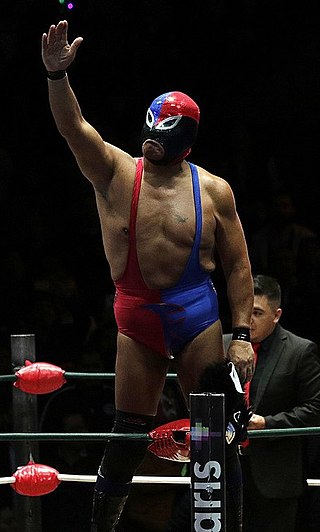
Fuerza Guerrera is a Mexican Luchador enmascarado who made his debut in 1978. In his career Guerrera has worked for every major wrestling organization in Mexico including Consejo Mundial de Lucha Libre (CMLL), AAA, Universal Wrestling Association (UWA), World Wrestling Association (WWA) and International Wrestling Revolution Group (IWRG). Throughout his career Fuerza Guerrera has held many titles for CMLL, AAA and IWRG. Fuerza Guerrera's real name is not a matter of public record, as is often the case with masked wrestlers in Mexico where their private lives are kept a secret from the wrestling fans. Only his paternal surname is known, as his son Eduardo Aníbal González Hernández' name is a matter of public record making Fuerza Guerrera's paternal surname "González" as well. Eduardo González is better known as luchador Juventud Guerrera. Fuerza Guerrera is Spanish for "Warrior Strength", not to be mistaken for the surname Guerrero.

The CMLL World Trios Championship is a professional wrestling championship promoted by Consejo Mundial de Lucha Libre (CMLL) in Mexico. The title has existed since 1991 and is contested for by teams of three wrestlers. Hornbaker, Tim (2016). "Statistical notes". Legends of Pro Wrestling - 150 years of headlocks, body slams, and piledrivers (Revised ed.). New York, New York: Sports Publishing. p. 550. ISBN 978-1-61321-808-2. Professional wrestling is a sport in which match finishes are predetermined. Thus, win–loss records are not indicative of a wrestler's genuine success based on their legitimate abilities - but on now much, or how little they were pushed by promoters
</ref>
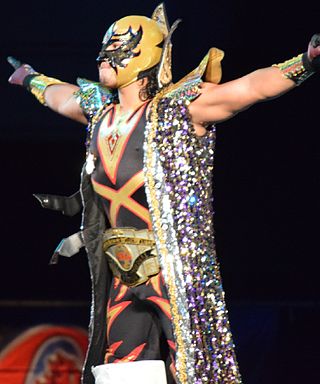
The CMLL World Welterweight Championship is a professional wrestling world championship in the Mexican professional wrestling promotion Consejo Mundial de Lucha Libre (CMLL). The official definition of the welterweight division in Mexico is between 70 kg (150 lb) and 78 kg (172 lb) but the official weight limits are not always adhered to. As with other professional wrestling championships, it is not won or lost competitively but is instead scripted by the bookers of a wrestling promotion. The title is awarded after the chosen wrestler "wins" a match.
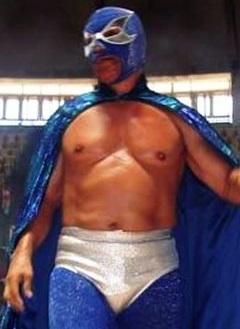
Juan Baños was a Mexican luchador enmascarado, or masked professional wrestler better known by the ring name Lizmark. The name was taken from the German battleship Bismarck. He was a multiple-time champion, having held singles and tag team championships in both Empresa Mexicana de Lucha Libre / Consejo Mundial de Lucha Libre (EMLL/CMLL) and Asistencia Asesoría y Administración (AAA). In 2001, Lizmark was inducted into the Wrestling Observer Newsletter Hall of Fame. His nickname was El Geniecillo Azul, which is Spanish for "The Little Blue Genius". He has two sons who are also professional wrestlers, Lizmark, Jr. and El Hijo de Lizmark.

Jesús Javier Hernández Silva was a Mexican professional wrestler known under the ring name Oro (Gold), a Mexican luchador enmascarado, or masked professional wrestler. Hernández died in 1993 as a direct result of a wrestling match. He was a second-generation wrestler, and several of his brothers and cousins were also wrestlers. His nephew works for the Mexican professional wrestling promotion Consejo Mundial de Lucha Libre (CMLL) as Oro Jr. as an homage to his uncle.

Juan Manuel Rodriguez Carillo was a Mexican luchador, best known by his ring name Bestia Salvaje, who competed in Mexican and international promotions during the 1980s and 1990s, most notably with Emilio Charles Jr. and Scorpio Jr. as part of the stable Los Talibanes. A second-generation wrestler, he was the son of Espectro II, the brother of Corazón Salvaje and the brother-in-law of Charrito de Oro.
Daniel López López is a Mexican luchador and trainer, best known under the ring name El Satánico. He was originally an enmascarado, but lost the mask early in his career and has performed unmasked ever since. The majority of his in-ring career was spent in Consejo Mundial de Lucha Libre (CMLL), where he worked as a rudo.

Sergio Emilio Charles Garduño was a Mexican luchador, who is best known under the ring name Emilio Charles Jr. Over the years, Charles worked for all of the major Mexican professional wrestling promotions, including Consejo Mundial de Lucha Libre (CMLL), Asistencia Asesoría y Administración and International Wrestling Revolution Group.
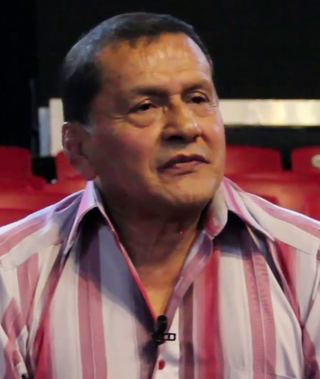
Arturo Beristain is a Mexican retired professional wrestler, or Luchador in Spanish, who works as a wrestling trainer at the Mexican professional wrestling promotion Consejo Mundial de Lucha Libre's (CMLL) gym in Mexico City, Mexico. Beristain is best known for working under two different ring names, Talismán and El Hijo del Gladiador; both personas started out as enmascarados, or masked, and Beristain lost both masks in Luchas de Apuestas. He lost the Talismán mask to Atlantis in 1984 and the Hijo del Gladiador mask to Rencor Latino in 2000. As Talismán, Beristain won the Mexican National Welterweight Championship twice, the Mexican National Middleweight Championship and the Mexican National Lightweight Championship. As el Hijo del Gladiador he has won the CMLL World Trios Championship with Gran Markus, Jr. and Dr. Wagner Jr. and the IWRG Intercontinental Middleweight Championship. When Beristain lost the "Hijo del Gladiador" he was announced as "Arturo Beristain Ramírez" to further the storyline that he was actually the son of wrestler "El Gladiador", but his last name is not actually Ramírez.

Juan Manuel Zúñiga was a Mexican professional wrestler, or Luchador as they are called in Spanish, best known for working under the ring name Ángel Azteca since the late 1980s. Zúñiga is not related to wrestlers "Ángel Azteca, Jr." and "Ángel Azteca II", instead they paid Zúñiga to use the name and image. As Ángel Azteca Zúñiga worked as an enmascarado, or masked wrestler, until losing a match against Arkangel de la Muerte in 2003 where he was forced to unmask.
Águila Solitaria is a Mexican Luchador enmascarado, or masked professional wrestler. Águila Solitaria's real name is not a matter of public record, as is often the case with masked wrestlers in Mexico where their private lives are kept a secret from the wrestling fans. His ring name, Águila Solitario, is Spanish for "Lone Eagle", which is reflected in the eagle wing design on his mask. Águila Soltaria made his professional wrestling debut in 1978 and since 1997 has only wrestled a limited schedule.
Javier Prado Valaguez is a Mexican retired Luchador, or professional wrestler, best known under the ring name Chamaco Valaguez. Valaquez also wrestle as the enmascarado (masked) character Platino, the original version until 1991 when someone else took over the character. Valaquez' two sons are also professional wrestlers working under the names Apolo Valaquez and Nosferatu. In early 2019 he was appointed president of the boxing and professional wrestling commission in Cuernavaca.
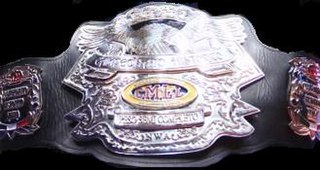
The NWA World Historic Middleweight Championship is a professional wrestling championship promoted by Consejo Mundial de Lucha Libre (CMLL). The official definition of the middleweight weight class in Mexico is between 82 kg (181 lb) and 87 kg (192 lb), but is not always strictly enforced. For example, previous NWA World Historic Middleweight Champion Último Guerrero is billed as weighing 95 kg (209 lb). Místico is the current champion, he is the eighth champion overall and he is in his first reign.
Los Metálicos was a Mexican professional wrestling group, called a stable, who worked in Consejo Mundial de Lucha Libre (CMLL) between 1991 and 1993. The group worked as a tecnico faction. Most of the members of the team were brothers, part of the Hernández wrestling family, with only Bronce I, Platino I and Platino II are not related to the rest of the team. The team used metallic gimmicks such as Oro ("Gold"), Plata ("Silver"), Bronce ("Bronze"), and Platino ("Platinum") and all started out as enmascarados, or masked wrestlers with only one member being unmasked before his retirement or death.

Roberto Aceves,, better known under the ring name Bobby Bonales, was a Mexican luchador, or professional wrestler who was active during the early days of Lucha Libre in Mexico, making his debut in 1934. Aceves son Daniel Aceves is an Olympic medal winner in Greco-Roman wrestling. As Bonales Aceves held several championships including the NWA World Welterweight Championship, the Mexican National Middleweight Championship and the Mexican National Lightweight Championship. In recent years Mexican wrestling promotion Consejo Mundial de Lucha Libre (CMLL) has honored Bonales on several occasions. Known as La Maravilla Moreliana ; Bonales innovated the Topé Suicida wrestling moves.

Homenaje a Dos Leyendas (2016) was a professional wrestling pay-per-view show event, scripted and produced by Consejo Mundial de Lucha Libre. The Dos Leyendas show took place on March 18, 2016 in CMLL's main venue, Arena México, Mexico City, Mexico. The event was to honor and remember CMLL founder Salvador Lutteroth, who died in March 1987. Starting in 1999 CMLL honored not just their founder during the show, but also a second lucha libre legend, making it their version of a Hall of Fame event. For the 2016 show CMLL commemorated the life and career of wrestler Lizmark. This was the 18th March show held under the Homenaje a Dos Leyendas name, having previously been known as Homenaje a Salvador Lutteroth from 1996 to 1998.
The Mexican National Championships is a group of Lucha libre professional wrestling championships that are sanctioned by Comisión de Box y Lucha Libre Mexico D.F.. While the Commission sanctions the championships, it does not promote the events in which the championships are defended. Being professional wrestling championships, they are not won legitimately; they are instead won via a scripted ending to a match or awarded to a wrestler or wrestlers as a result of a storyline. The earliest Mexican National Championship, the Mexican National Heavyweight Championship, was created as far back as 1926. The Mexican National Welterweight Championship crowned its first champion on June 17, 1934, making it the oldest, still active, professional wrestling championship. Eléctrico, the current Lightweight champion, is the longest reigning Mexican National Championship, having won the title on August 13, 2013. Atlantis, the reigning Light Heavyweight Champion, has the shortest active reign of any champion, having defeated Mephisto for the championship on August 25, 2015.

Juicio Final (1995) was the name used for two major professional wrestling shows, scripted and produced by Consejo Mundial de Lucha Libre (CMLL). The shows took place on December 1 and December 15, 1995 in Arena México, Mexico City, Mexico. The shows served as the year-end finale for CMLL before Arena México, CMLL's main venue, closed down for the winter for renovations and to host Circo Atayde . The shows replaced the regular Super Viernes shows held by CMLL since the mid-1930s. This was the seventh year that CMLL used the name "Jucio Final" for their year-end show, a name they would use on a regular basis going forward, originally for their year even events but later on held at other points in the year.














